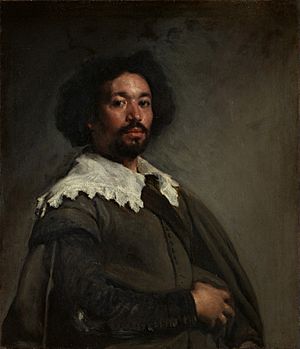Portrait of Juan Pareja facts for kids
The Portrait of Juan Pareja is a famous oil painting created by the Spanish artist Diego Velázquez. He painted it in 1650. This artwork measures about 81.3 by 69.9 centimeters (32 by 27.5 inches). Today, you can see it at the Metropolitan Museum of Art in New York City. Juan Pareja was Velázquez's assistant and also his slave at the time. He worked in Velázquez's art studio. Velázquez painted this portrait while they were in Rome, Italy. The painting was shown to the public in March 1650 at the Pantheon, a famous building in Rome. Many people admired the painting. Later, Juan Pareja became a painter himself. Velázquez gave him his freedom in 1654.
Contents
About the Painting
This portrait is one of Velázquez's most well-known works. It shows Juan Pareja, who was an important part of Velázquez's life. The painting captures Pareja's personality and strength. Velázquez was known for his realistic style. He made his subjects look very lifelike. This painting is a great example of his skill.
Who Was Juan Pareja?
Juan Pareja was born in Antequera, Spain. He was of Moorish background. He became an assistant in Velázquez's workshop. This meant he helped prepare paints and canvases. He also helped with other tasks around the studio. Even though he was a slave, he learned a lot about art. He watched Velázquez work every day. This experience helped him become an artist himself.
Painting in Rome
Velázquez traveled to Rome, Italy, in 1649. He went there to buy artworks for the King of Spain. Juan Pareja went with him as his assistant. While in Rome, Velázquez painted this portrait of Pareja. It was painted just before Velázquez started his famous portrait of Pope Innocent X. Painting Pareja helped Velázquez prepare for the Pope's portrait. It allowed him to practice his skills.
A Masterpiece Revealed
The Portrait of Juan Pareja was first shown in public in Rome. It was displayed at the Pantheon in March 1650. This was a big event for artists. Many people saw the painting. It received a lot of praise and admiration. People were amazed by how real Pareja looked in the painting. This public display helped Velázquez's reputation grow even more.
Juan Pareja's Freedom and Future
In 1654, Velázquez officially freed Juan Pareja. This was a significant moment for Pareja. After gaining his freedom, Juan Pareja continued his career as a painter. He created many religious paintings. His works were often displayed in churches. He became a respected artist in his own right. This portrait is a reminder of his journey and talent.


